
Collected and Edited by David Frydenlund (last revised in 2013)
Pioneering and Rope Work
Note that for almost all Pioneering events, I advocate allowing any form of lashing which appears on the web as a legitimate lashing for the joint type required. There are at least two forms, and in some cases as many as six forms, for any given type of lashing. Almost every lashing has a "standard form" and a "speed form". The "standard form" varies from country to country, region to region, and even trade to trade. If you are only going to allow the forms in the BSA Manual or the Pioneering Merit Badge Book (or some other standard) say so ahead of time. Usually the best test of a lashing or knot is "Did it work?"
I also advocate requiring the team to take apart their work as part of the contest. Good knots and lashings are easy to tie, do the required job, and are easy to untie. There is nothing quite like disassembly to drive home the value of properly selected knots and the horror of knots that jamb (usually an improperly selected or tied knot). I teach, allow, and encourage "slipped" forms of knots which aid quick and easy untying.
That said, there are times when safety is an issue. In those cases the task should be inspected for correctly selected and applied work. Ideally the clock should run but in some cases you may need to stop the clock while a detailed inspection is made of the apparatus to insure that it will function safely.
Tripod Building
Each patrol must build a tripod by using three 8 - 10 foot poles as the legs and three 6 - 8 foot poles as the crossbeams. There will be one 12 foot rope which will be used as the top tripod lash, as well as six 8 foot ropes which will be use to lash the crossbeams. Before the time starts the Patrol may arrange the materials any way they like except that no item, rope or pole, may be touching any other item. At the end, all six poles will be laid parallel and less than one foot apart, all lines will be coiled and laid at the ends of the poles. The sequence is, start clock, build tripod, three members of the Patrol stand simultaneously (one on each crossbeam) for ten seconds, the tripod is disassembled, the parts are laid out, time stops. Lowest time wins. Any readily recognized form of the lashings (speed or straight, racked or unracked) with appropriate knots is allowed. Improper lashings (wrong knots, wrong frappings, and/or wrong wrappings) incur a 20 second penalty for each joint. Some version of this event is the most common International Jamboree/Camporee event.
Poison River Crossing
Two ropes are laid in parallel ten feet apart to represent the banks of the poison river. The team is given five 8 foot 2x3s or 2x4s, and fifteen 8 foot ropes. Using these materials they need to get the Patrol across the river without touching the "water". A Scout that touches the water must go back to the first bank. The boards, when lying in the water (flat on the ground), are assumed to be the same as the water and touching them sends a Scout back to the first bank. This is a timed event and the clock is stopped when all the Scouts are across the river and whatever device they have assembled is disassembled and on the second bank. Lowest elapsed time wins. Hint: The normal way of doing this is to build an "A" frame.
Rope Gulley Crossing
A location is selected with two trees or posts a suitable distance apart (10 – 20 feet depending on quality of rope available and age and experience of the Scouts). Ropes or spars are laid about two feet from the trees to mark the banks of the gulley. No Scout is allowed to touch the ground between these marks. The Patrol is divided into two teams and one is put by each tree with a suitable coiled rope. The task is for the two teams to exchange sides of the gulley. This is a timed event. The clock stops when each team is on the opposite side of the gulley from where they started and are holding their coiled rope.
Variation 1. They are required to use a particular method. Possible methods include single rope shinny, dual rope crawl, hand and foot ropes.
Variation 2. They are required to tighten their ropes to a particular standard using a particular method. Methods might include prussik and: block and tackle, spanish windlass, come along, z-rig.
Variation 3. Given equipment suitable to the task (carabiners, extra ropes, pulleys) they are required to move packs or boxes or a stretcher with victim across the gulley.
Variation 4. Given equipment suitable to the task they are to rig a system that lets them put one patrol member over the middle of the gulley and lowers him down to pick up an object.
Expansions for all these ideas can be found in any good manual or book on river rescue.
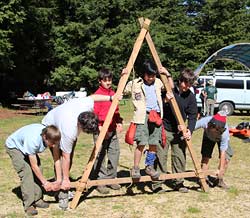
Walking Trestle
Using materials provided the Patrol builds a trestle (the competition staff will dictate whether it is an "A" Frame or an "H" Frame). One member of the Patrol rides on the trestle while the remainder of the Patrol walk it to a mark about 25 feet away, round the mark, and walk it back to the start point. At the start the Patrol may organize the materials anyway they like except no part of the materials shall be over the start line and no rope or spar may be touching any other rope or spar. The clock stops when all the parts of the trestle are over the start line and free of all the other parts of the trestle. If the rider falls off the trestle they must go back to either the start line or the turn mark, whichever they passed last, and begin again. If the trestle fails, the Patrol is disqualified. This is a timed event. Fastest time wins.
Sedan Chair Race
Using materials provided an "H" frame trestle is lashed together. One Patrol member sits at the "cross" while the rest of the Patrol carry him around a course. On crossing the finish line the chair is disassembled. The clock stops when all the parts of the trestle are over the start line and free of all the other parts of the trestle. If the rider falls off the trestle they must go back to either the start line or a turn mark, whichever they passed last, and begin again. If the trestle fails, the Patrol is disqualified. This is a timed event. Fastest time wins.
Lashed Stretcher Race
Using the materials provided, including two 8 foot 2x3s, two 3 to 4 foot 2x3s, four 6 - 8 foot lashing lines, and one 50 foot (or two 25 foot) lacing lines, construct a lashed stretcher, load a victim on it, carry the victim through a designated course, return the victim to the start, disassemble the stretcher and make up all lines. This is a timed event. Lowest time wins. The weight of the victim and difficulty of the carry course should be selected according to the age and experience of the Scouts. Generally, two duffel bags, each with about 30 - 40 pounds of sand, makes a good victim. Around a mark 25 feet away is a good run. A stretcher design for this event can be found at: http://paratusinstitute.com/wp-content/uploads/2016/02/Wilderness-Stretchers.pdf
Rope Stretcher Race
Using the rope (100 – 120 feet of ¼ inch or larger) provided build a stretcher, load a victim on it, carry the victim through a designated course, return the victim to the start, disassemble the stretcher and coil the line. This is a timed event. Lowest time wins. The weight of the victim and difficulty of the carry course should be selected according to the age and experience of the Scouts. Generally, two duffel bags each with about 30 - 40 pounds of sand, makes a good victim. Around a mark 25 feet away is a good run. A stretcher design for this event can be found at: http://paratusinstitute.com/wp-content/uploads/2016/02/Wilderness-Stretchers.pdf
Burtoning Rigs
In nautical environments a Burtoning Rig is a way to move cargo by suspending it between two blocks or pulleys which are some distance apart. Pulling in on both lines raises the cargo. Letting out on both lowers the cargo. Letting out on one while pulling in on the other moves the cargo toward the one pulling. Depending on the rate of pulling and letting out the cargo may also move up or down. With two blocks the cargo can move anywhere along a line. With three blocks it can move anywhere in an area. Four blocks makes control easier. This raises all kinds of possibilities for Pioneering projects/contests.
Imagine two inverted buckets four feet apart with a pot of water, with bail up, sitting on one of the bucket bottoms. The task is to move the water from one bucket bottom to the other. If I can line up two pulleys with the buckets I can Burton the pot from one to the other.
If I build a tripod or an "A" frame trestle I can hang a pulley from the top. By building two tripods or two "A" frames I can have a Burton Rig.
The low skill event would be to use twelve spars and 14 lashing lines to build two tripods. Use a short line to hang a pulley in each tripod. Pass a 20 foot line through each pulley and tie the end to the weighted hook. Maneuver the hook to catch the bail. Lift the water pot and move it to the other bucket. Disassemble the rig and stow all gear. A timed event. The skills here are tripod lashing, square lashing, bowline?, two half hitches?, and maybe heaving line. Plus team work.
A higher skill event would be to build two "A" frames and have to support them with staked guy lines. The highest skill event would call for a tripod on one side and an "A" frame on the other. By prescribing the knots to use, and by giving them lines for guy lines that are too short, it is possible to have an event that uses every knot in the standard seven, plus shear lashing, tripod lashing, and square lashing. Let your imagination roam and build an event.
Derricks
In nautical environments a Derrick is a way to move cargo by suspending it from the movable end (head) of a boom where the other end (base or foot) is fixed in location but hinged in two dimensions. The typical derrick is controlled by three lines. A topping lift controls the angle of the boom above the ground. Two vangs control movement left and right. In addition there is usually a pulley at the end of the boom which allows a whip to move cargo up and down. This raises all kinds of possibilities for Pioneering projects/contests.
Imagine two inverted buckets four feet apart with a pot of water, with bail up, sitting on one of the bucket bottoms. The task is to move the water from one bucket bottom to the other. As long as both buckets are under the swing area of the boom, it is possible to move the pot from one bucket to the other.
Suppose we build a tripod to act as the base for the derrick and also to act as an anchor point for the topping lift. We then loosely lash the base of the boom to one leg of the tripod. We tie a pulley into the top of the tripod and run a line to the head of the boom. That gives us in and out control. Then we tie a pulley to the head of the boom, rig it with a line with a weighted hook. That gives us a whip. Two free lines go to the head of the boom and we have vangs. Four lines to control makes for good team building.
Put one Scout on each line. The sequence to pick up the pot is to boom in or out and vang left or right until the whip is directly over the pot. Then one lowers the whip and adjusts whip, lift and vangs until the hook is through the bail. Then whip up until the pot is free. Then vang until the boom is aligned with the target bucket. Then boom up or down until the pot is over the bucket. Whip down gently to settle the pot. Fiddle the lines until the hook is free. Job done.
Usually these are timed events with penalties for lost water. Let your imagination roam and build an event.
GIANT KNOT
Six Scout team; judged on time. Given a 30 foot rope, tie a clove hitch to a post in the middle of a 21 foot circle. You may not enter the circle.
Remote Clove Hitch
Given a XX foot rope, tie a Clove Hitch to a tree/post in the middle of a YY radius circle. You are not allowed to enter the circle. This is a timed event. As a practical matter, despite the Baden Powell description above (possibly mistranscribed) the minimum length of the rope should be at least four times the radius of the forbidden circle plus twice the circumference of the tying post or tree. There are elegant ways to do this with a length of rope only a little more than three times the radius but they are beyond what most Scouts could figure out.
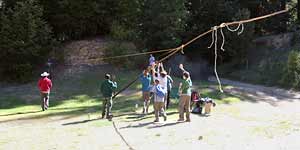
Flag Pole
The Patrol is given three 8 foot spars, six lashing lines and three 30 foot guy lines. The objective is to create a 20 foot flagpole with their Patrol, or a generic flag on a staff, into a vertical position. They then take it down and disassemble it. The primary skill is round lashings. This is a timed event. The problem is made more interesting if all the lines are 8 footers and the guy lines need to be made by tying three eight foot lines together with Sheet Bends. A further complication can be added by requiring the guy lines to be made fast to stakes and for the pole to be free standing before it is declared ready to lower.
POLE RAISING
Six Scout team; judged on time. There is a 10 foot pole in a 20 foot diameter circle with one end of the pole touching the edge of the circle. You have two ropes, 60 feet in length. Without entering the circle, erect the pole in the center of the circle.
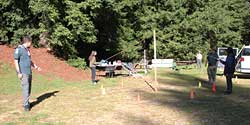
Pole Raising
There is an eight foot spar (2x4) in an 18 foot diameter circle. One end of the spar is touching the edge of the circle while the other end is pointed at the hole. In the center of the circle there is a one foot diameter hole, six inches deep. There are three 50 foot (or six 25 foot) ropes. The center of the spar is marked with a band. You are not allowed to step into the circle but you are allowed to reach into the circle. At no time will the band marking the center of the spar be outside of the circle. The job of the Patrol is to stand the spar vertically with one end in the hole and hold it that way for 15 seconds. Then return the spar to its original position with all the ropes removed. This is a timed event. Lowest time wins.
Longest Pole
Using the spars and ropes provided the Patrol has twenty minutes to make the longest pole they can. The pole should be made by overlapping spars with round lashings. A pole is only a pole if it can be supported at each end two feet off the ground with no part sagging to touch the ground. If, at measure time, the pole sags to the ground it is counted as zero length. Otherwise, longest pole wins. This event can be done with spars as short as 2½ feet or as long as four feet. Spars are typically 2x3s, 2x2s, 1 inch round stock, or natural straight wood 1 – 2 inches in diameter. The problem is made harder by irregular length and diameter spars. It is a rare Patrol that can do more than twenty lashings in twenty minutes. The minimum materials for this event include twelve spars and 22 lashing lines. By doubling that one can have two Patrols working simultaneously.
LOG PULL RELAY
Six Scout team with a 9 foot rope; judged on time. Teams are arranged three Scouts at each end of the course. The first Scout ties the rope to a log and pulls the log to the other end of the course to be pulled back by the second Scout, and so on. The timber hitch is a fast knot to tie but, if they make it a single, they must keep on the tension at all times.
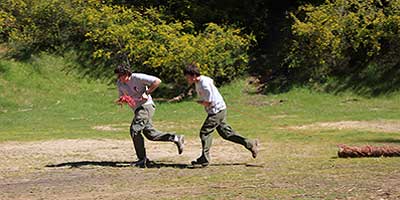
Log Pull Variant
Logs to the Mill
The Patrol needs to move ten logs (ideally 4 foot long, 4 inches in diameter, 4x4s work) to the mill. The logs are laid parallel on the ground, perpendicular to the path to the mill. The Patrol is issued one length of 20 feet of line. They must tie a choker (Timber Hitch with Killich [Marlin, Half] Hitch) and drag the logs, one at a time to the mill where they are lined up in parallel, perpendicular to the path from the woods. This is a timed event and the clock stops when the all the logs are across the line, lined up in parallel and the choker is untied. In one variation the Patrol may organize themselves any way they want to accomplish this task. In another variation each Scout, or a pair of Scouts, must attach the choker, drag the log, position the log, and untie the log before handing off to the next relay team member(s). If emphasizing planning and team work, the rule is added that logs may only be touched by hand to lift an end to apply or remove the choker. All other positioning must be done using the rope.
LOG HOIST
One Scout; judged on time. Throw a 30 foot rope over an 8 foot high crossbar 15 feet away. Run up and tie a timber hitch to a log (18 inches long). Hoist the log free of the ground and hitch the rope to a peg at your starting point. The log must remain clear of the ground.
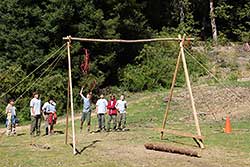
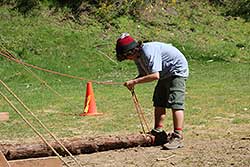
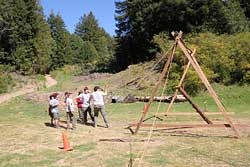
Log Hoist Variant
Log Lift
A crossbar is placed 8 - 10 feet above the ground, ideally six feet across. Under the cross bar is a log (sometimes propped up at one end on a smaller log). Some distance away (typically 10 – 20 feet), perpendicular to the center of the crossbar is a tying point. In a simple contest it is a post set in the ground. Sometimes it is a tent peg. Sometimes it is a log, parallel to the crossbar, into which an ax can be set. In a full event the first Scout is handed a rope and told to coil it anyway he wants and set it on the ground. At start, the Scout takes an ax and sets it into the log, handle parallel to the log. He then heaves the line over the crossbar. (If a Scout fails after five tries to get the line over the bar, another Scout may heave the line for him but he must do the remainder of the event). The line is made fast to the log using a choker (typically a Timber Hitch with Killich [Marlin, Half] Hitch). The log is then lifted clear of the ground by pulling on the other end of the line which is taken to the tying point (ax handle or post) and tied using a Clove Hitch. (As an alternative a fixed loop is made with a Bowline or a sliding loop is made with Two Half Hitches and the loop is dropped over the tying point). The Scout then claps five times during which the log must remain clear of the ground. Then the Scout lowers the log, removes the ax, retrieves the line and hands it off to the next Scout who repeats the process. Time stops when the last Scout hangs the coiled line on the ax handle. This is a timed event and the score is the average time.
The size of rope, log, and ax are a function of the age and experience of the participants. This has been done by Venturers with a full ax, a 150 pound log and ½ inch rope. Typically it is done with a ¾ ax, a 20 pound log, and ¼ inch rope.
Trebuchet/Catapult
Using materials provided the Patrol lashes together a Trebuchet or Catapult and launches a projectile that must cross a distance line. They then disassemble the device and return all the parts to the starting position. This is a timed event. Lowest time wins.
Bridge/Tower Building
This is here mainly for completeness. Most Patrols today lack the skills and experience to build an actual bridge or tower within the time normally available for a camporee event. That said, in a highly competitive District, it may be possible to do such a competition. To make this workable all materials necessary should be provided to the Patrol and all should be clearly marked. The nature of the project should be made known well in advance of the camporee so that Scouts can practice the structure beforehand. Structures that I have seen completed in under 30 minutes include: A Monkey Bridge with fixed anchor points, a two "H" Frame Trestle Bridge, a two "A" Frame Trestle Bridge, a Three Tripod Tower with platform, a Square Tower, a Double (one inverted) Tripod Tower. Bridges are an especially interesting (and fun) project when actually built spanning water. Most Bridge or Tower events are timed. Fastest wins.
Heaving Lines/Rescue Throw
The target is a series of 10 cones or stakes. The middle two (ideally larger or a different color) are two feet apart. The remainder stretch out to the two sides, one foot apart. The idea is to throw a heaving line that passes between the center two marks. Such a throw would count five points. One mark to either side, four points. Two marks, three etc. Each Scout throws twice for score and can score a maximum of ten points. The Patrol score is the average of the Scout scores. High score wins. The distance and size of the throw lines should be appropriate to the age and experience of the Scouts.
Grappling Hooks
A target is created which is a five foot section of ¾ inch PVC pipe. Depending on the grappling hooks used it may be desirable to put a 2-3 inch diameter plywood disc or a drilled 3.5 inch length of 2x4 at the center of the pipe. The Patrol is provided two (or more) grappling hooks on lines. The pipe is set parallel to the throw line. The object is to pull the pipe across the throw line by getting at least two hooks across the pipe and pulling it in a coordinated fashion. This is a timed event. This can be done with commercial hooks or hooks fashioned from wood or coat hangers. The distance should be appropriate to the age and experience of the Scouts. As sometimes run, if the pipe exceeds a 45 degree angle from the throw line it is turned back to parallel by the judge.